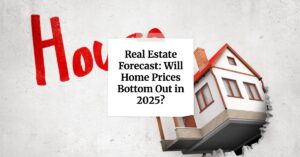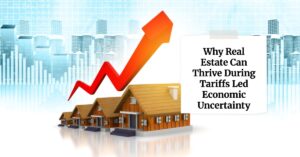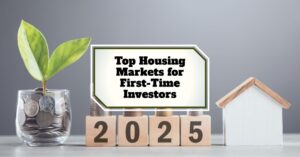Will home prices bottom out in 2025? No, while the wild price increases of the pandemic years have cooled down, experts predict continued, albeit slower, growth. We're talking about increases in the range of 1.3% to 3.5%, according to various forecasts. This means the market is stabilizing, not crashing, and we're unlikely to see a massive drop in home values.
Let's dive into why this is the case and explore what's really happening in the housing market.
Real Estate Forecast: Will Home Prices Bottom Out in 2025?
The Housing Market Today: A Look at the Numbers
As we move through 2025, it's important to look at the most recent data to get a clear picture. It's easy to get caught up in headlines, but numbers tell a more grounded story. Here's a snapshot of what's happening:
- Price Growth: The S&P CoreLogic Case-Shiller Home Price Index showed a 4.1% annual gain in January 2025. While not the explosive growth of previous years, it's still positive.
- Median Home Price: The median existing home sale price hit $398,400 in February 2025, marking 20 straight months of year-over-year increases, says the National Association of Realtors.
- Expert Predictions: Experts are forecasting continued increases. J.P. Morgan Research anticipates a 3% rise, while Fannie Mae estimates a 3.5% increase. The Mortgage Bankers Association is a bit more conservative, projecting a 1.3% rise.
Here's a quick look at those expert forecasts:
| Source | Prediction for 2025 Home Price Growth |
|---|---|
| J.P. Morgan Research | 3% |
| Fannie Mae | 3.5% |
| Mortgage Bankers Association | 1.3% |
Personally, I see these figures as a sign of a market that's finding its footing after a period of intense activity. The days of bidding wars and houses selling for way over asking price seem to be behind us, but that doesn't mean the market is about to collapse.
Why a 2025 Bottom Out is Unlikely
A lot of people are nervous about the housing market because they remember the crash of 2008. But the situation today is very different. Here's why:
- Low Inventory: There simply aren't enough homes for sale. The housing supply is only around 3.5 months' worth, which is far below the 5–6 months needed for a balanced market. This lack of homes keeps prices from falling too much.
- Mortgage Rates: While mortgage rates have been up, they aren't so high that they're completely stopping people from buying homes. Plus, with potential rate cuts on the horizon, this could ease things a bit.
- Economic Stability: The economy, while not perfect, is generally stable. Inflation has cooled down, which means the Federal Reserve is less likely to raise interest rates aggressively.
- Strong Demand: There's still a lot of demand for homes, especially from Millennials and Gen Z, many of whom are entering their prime home-buying years.
- Stricter Lending Standards: Banks are much more careful about who they lend money to than they were in the years leading up to the 2008 crash. This means fewer people are taking out loans they can't afford, which reduces the risk of foreclosures.
Learning from the Past: The 2008 Exception
It's important to remember that the 2008 housing crisis was an exception, not the rule. The crisis was caused by:
- Subprime Lending: Banks were giving mortgages to people who couldn't afford them.
- Overbuilding: There were too many homes being built.
- Speculative Buying: People were buying homes hoping to quickly flip them for a profit.
These factors aren't as prevalent today. Foreclosures are down, indicating that people are generally able to keep up with their mortgage payments. This is a huge difference from 2008.
Factors Influencing Home Prices in 2025 (and Beyond)
Let's dig into some of the key factors that will continue to shape the housing market:
- Persistent Low Inventory:
- The housing shortage is a big deal. Builders haven't been able to keep up with demand, especially after the pandemic.
- There are several reasons for this shortage:
- Labor shortages in the construction industry.
- Rising material costs.
- Zoning regulations that limit the construction of new homes.
- The lack of homes means that when a good property comes on the market, it tends to attract a lot of interest, which helps to support prices.
- Mortgage Rates and Affordability:
- Mortgage rates have a direct impact on how much people can afford to spend on a home. When rates go up, affordability goes down.
- In 2025, rates are expected to hover in the mid-to-high 6% range.
- This has definitely made it harder for some people to buy homes, but it hasn't completely stopped them.
- The Federal Reserve's decisions about interest rates will continue to play a big role in the housing market. Any rate cuts could provide a boost to demand.
- Economic Stability:
- A healthy economy is good for the housing market. When people have jobs and feel confident about the future, they're more likely to buy homes.
- Inflation is a key factor to watch. If inflation stays under control, the Federal Reserve won't need to raise interest rates aggressively.
- The labor market is also important. A strong job market means more people can afford to buy homes.
- Regional Variations:
- The housing market isn't the same everywhere. Some cities and regions are doing better than others.
- For example, some areas that are prone to natural disasters, like hurricanes or wildfires, may see price pressures due to rising insurance costs.
- On the other hand, some Midwest markets are seeing strong demand and limited supply, which is driving up prices.
- It's important to look at what's happening in your local market to get a sense of what's likely to happen to home prices.
- High Construction Costs:
- The high cost of building new homes is making it harder to increase the housing supply.
- Builders are facing challenges like:
- High material costs (lumber, steel, etc.).
- Labor shortages.
- Rising land costs.
- This is limiting the number of new homes being built, which is helping to support prices for existing homes.
What About a Recession?
Many people worry about the impact of a potential recession on the housing market. Historically, home prices haven't always fallen during recessions. In fact, in many cases, they've remained relatively stable.
The 2008 crash was an exception because it was caused by problems within the housing market itself (subprime lending, overbuilding, etc.). If we were to enter a recession now, it would likely have less of an impact on home prices because the underlying issues that caused the 2008 crisis aren't present today.
My Take: A Balanced Perspective
As someone who's followed the housing market for a long time, I think it's important to have a balanced perspective. It's easy to get caught up in the headlines and make decisions based on fear or greed. But the reality is that the housing market is complex, and there are many factors that can influence prices.
I believe that the most likely scenario for 2025 is continued, moderate price growth. I don't see a crash coming, but I also don't expect to see the same kind of rapid price increases that we saw during the pandemic.
What This Means for You
- For Buyers: If you're thinking about buying a home, don't try to time the market. Focus on finding a home that you can afford and that meets your needs. Waiting for prices to bottom out might mean missing out on the opportunity to buy a home that you love.
- For Sellers: If you're thinking about selling your home, now is still a good time to do it. Prices are still relatively high, and there's still demand from buyers. Just be realistic about your expectations and don't overprice your home.
- For Investors: If you're an investor, the housing market can still offer opportunities, but it's important to do your research and understand the risks. Focus on areas with strong fundamentals, like job growth and population growth.
In Conclusion
The data suggests that home prices are unlikely to bottom out in 2025. Instead, we can expect a more stable market with modest price increases. While there are always risks and uncertainties, the fundamentals of the housing market remain solid.
Remember, it's crucial to stay informed, consult with experts, and make decisions that align with your personal circumstances and financial goals. The housing market is a big investment, and it pays to be prepared.
Work with Norada, Your Trusted Source for
Real Estate Investment in the Top U.S. Markets
Discover high-quality, ready-to-rent properties designed to deliver consistent returns.
Contact us today to expand your real estate portfolio with confidence.
Contact our investment counselors (No Obligation):
(800) 611-3060
Also Read:
- Housing Markets With the Biggest Decline in Home Prices Since 2024
- Why Real Estate Can Thrive During Tariffs Led Economic Uncertainty
- Rise of AI-Powered Hyperlocal Real Estate Marketing in 2025
- Real Estate Forecast Next 5 Years: Top 5 Predictions for Future
- 5 Hottest Real Estate Markets for Buyers & Investors in 2025
- Will Real Estate Rebound in 2025: Top Predictions by Experts
- Recession in Real Estate: Smart Ways to Profit in a Down Market
- Will There Be a Real Estate Recession in 2025: A Forecast
- Will the Housing Market Crash Due to Looming Recession in 2025?
- 4 States Facing the Major Housing Market Crash or Correction
- New Tariffs Could Trigger Housing Market Slowdown in 2025
- Real Estate Forecast Next 10 Years: Will Prices Skyrocket?











